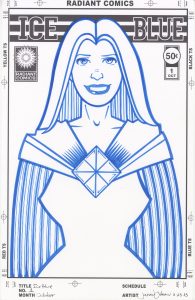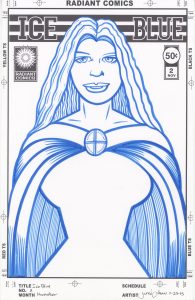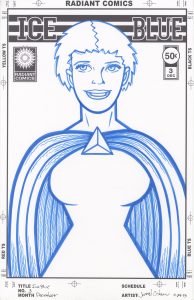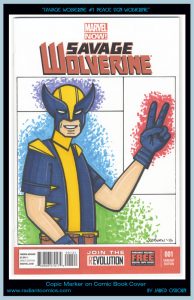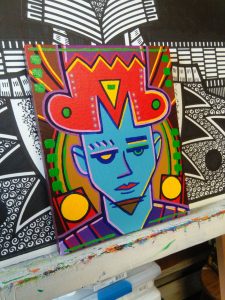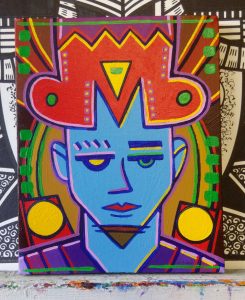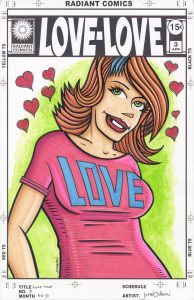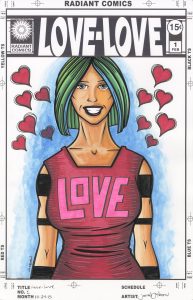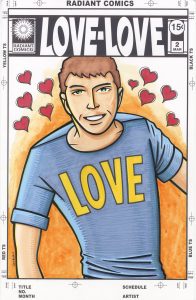I’ve been enjoying my color inks again this week. I recently wrote about my “Ice Blue” faux comic book covers that I made in blue acrylic ink but this time I was using the ink for something different. I was mixing something old with something new and coming up with a yet another series of drawings. My “Blue Punk” and “Red Punk” drawings.
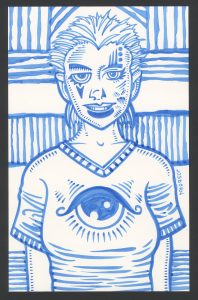
It started with me just wanting to use my color inks. The first question is usually “Use them to make what?”. That is often the hardest question to answer. Doing something takes a lot of work but figuring out what to do can be a real stumbling block to getting going. So I decided to mix a couple of ideas and use some old drawings.
The first idea was my comic book size faux comic book drawings. Not the eleven by seventeen inch full size comic book original art drawings but the print size six and a half by ten inch drawings. But I didn’t want to make faux comic book covers. No logos, no trade dress, and no paper markings. I wanted them to be drawings on their own. But for some reason I wanted them at that comic book size. I think because it’s fun to bag and board the final drawings. Makes them seem cooler somehow. And easier to handle.
The next thing I had to figure out was what to draw. That’s the eternal question. It takes a while to draw something and I wanted to use the ink and not spend so much time with a pencil. Even those “Ice Blue” drawings, as simple as they are, take a bit of time. I’d say penciling each “Ice Blue” figure takes about and hour and a half. Maybe two hours. And that’s a short amount of time to spend on a drawing.
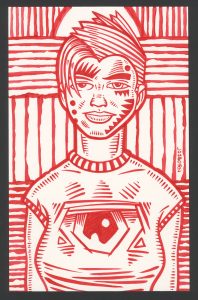
I could have gone with some spontaneous ink drawing. That’s where I draw in ink with no preconceived idea of what I want to draw. I do a lot of that but mostly at a smaller scale. One of the things about drawing that way is that you have to make a lot of spontaneous ink drawings to get a few good ones. That’s how the process works. That’s why I do them at the small size. Doing them at printed comic book size would mean a lot more work. And that is working on the drawing rather than working with the ink. Working with the ink is what I wanted to do.
I ended up looking through my old scans of drawings. Since I scan in all my art as a matter of course I have years and years worth of drawings as picture files on my computer. That makes them easy to look through. Some of those drawings got turned into finished works and some never did. Sometimes I even rework drawings into something new and that is what I did here. I decided I wanted to ink some figures/characters so I looked around and found some of my old “Message Tee” drawings that would be good for this new project. I made a hundred and fifty drawings for that strip of people standing there in T-shirts. They were often weird looking people. They were perfect for using again and making even weirder.
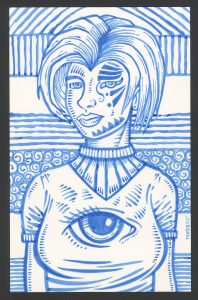
“Blue Punk #1” was the first of these. I didn’t even have the name yet but had the color. Since I had already worked with the blue ink I figured I’d start with that again. I printed out the drawing in blue line and onto bristol paper for inking. Since the drawings were fairly stripped down to begin with I decided I would add plenty of stuff in ink. I didn’t want to keep things simple as with the “Blue Ice” drawings. At first I stuck mostly to what was there in the original drawing but after that basic figure was inked I added more stuff.
The first and most obvious thing that I added was the giant eye in the middle of her shirt. As I was doing the initial inking I realized something had to go there. It was a wide open blank spot made to put writing in for my “Message Tee” strip. It couldn’t stay blank and I didn’t want to write anything there so I used one of my old favorites the all seeing eye. I’ve worked on many different variations of the all seeing eye over the years so it was natural for me to reach for it again. I could draw it right in ink and come up with a lot of variations. Plus it’s not the first time I’ve gone with giant eyes on chests. It seems like a natural to me. The strange radiating lines around the eyes came in part from eyelids and eyelashes and in part from motion lines. They create their own little world around the eye.
The backgrounds are a bit of a mash-up too. As I was inking the figures I had no idea what to do with the background. In the “Message Tee” strip they’re all filled with blocks of color. That wasn’t going to happen here so after some deliberation I decided on using a side of the brush technique to make linear patterns. They are sort of like the way I draw buildings in my ink drawings by building them up out of various horizontal, vertical, and diagonal lines. But in the “Punks” drawings I scaled up the technique and used it to make a flat but patterned background.
The rest of the drawing is all about marks. I threw lots of folds in the shirt and lots of little tick marks on the faces and arms. Plus the hair is filled with lines. None of these were in the original drawing but I wanted them there now. The face got even more decorated too. I like decorating faces in drawings. It the end the drawing looked a little like some weird punk rocker from an alternate world. I liked that and it gave me my name. Then I pulled out the red ink.
